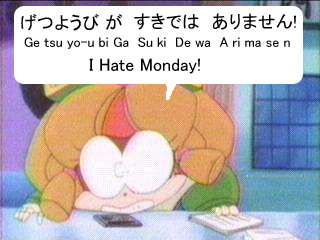Lesson 14: "Dates"
Well, we learned how to tell the time in our last lesson, so in this lesson, lets learn days and dates. The Japanese names for the days of the week all end with "-yobi". The first parts of the names come from different elements and celestial bodies. These are also associated with planets. Sailor Moon fans will already be familiar with some of these, such as Mars being associated with fire. Nichiyobi (knee-chee-yo-bee) = Sunday, Sun-day
Nichiyobi (knee-chee-yo-bee) = Sunday, Sun-day
Getsuyobi (ghee-tsue-yo-bee) = Monday, Moon-day
Kayobi (ka-yo-bee) = Tuesday, Fire-day (Mars)
Suiyobi (sue-e-yo-bee) = Wednesday, Water-day (Mercury)
Mokuyobi (moh-kuu-yo-bee) = Thursday, Wood-day (Jupiter)
Kinyobi (keen-yo-bee) = Friday, Gold-day (Venus)
Doyobi (doh-yo-bee) = Saturday, Ground/Soil-day (Saturn)
You can find out what day of the week it is by asking "Nan-yobi des' ka?", or, to ask what day today is, ask "Kyo wa nan-yobi des' ka?". "Kyo" (kayo) means "Today". "Yesterday" is "Kino" (Kee-noh) and "Tomorrow" is "Ashita" (ah-shee-tah). One episode KNT has the title "Ashita mo zettai Nihonbare!" which means "Tomorrow will be an absolutely beautiful day!"
Days of the month have names too. They are actually numbered, but as you've seen in our previous lessons, Japanese has different ways for counting different things, and days are one of those things. The first of the month is "Tsuitachi" (Su-ee-tah-chee), and the next 9 days are named based on the older Japanese numbers with "-ka" added:
Futsu-ka (foo-su-kah) = The second of the month
Mik-ka (mee-kah) = Third
Yok-ka (yoh-kah) = Fourth
Itsu-ka (ee-su-kah) = Fifth
Mui-ka (moo-ee-kah) = Sixth
Nano-ka (Nah-noh-kah) = Seventh
Yo-ka (yoh-kah) = Eighth
Kokono-ka (koh-koh-noh-kah) = Ninth
To-ka (Toh-kah) = Tenth
After that it's easy if you remember your Japanese numbers, just use the regular number, and add "Nichi" (Just like "Nichi" in "Nichiyobi" and "Konnichi wa"):
Ju-ichi-nichi = 11th, Ju-ni-nichi = 12th, etc. "Nichi" can also be used to ask what the date is by adding "Nan". "Nan-nichi des' ka?"
 Months are easy, they are just numbered 1 through 12. The name of each month is just uses the regular Japanese numbers, and adds "Gatsu". "Ichi-gatsu" = "One-month" = January. By now, you are probably understanding why knowing Japanese numbers is so important in learning Japanese. The Japanese used to have actual names for months instead of just numbers, but they don't use them anymore.
Months are easy, they are just numbered 1 through 12. The name of each month is just uses the regular Japanese numbers, and adds "Gatsu". "Ichi-gatsu" = "One-month" = January. By now, you are probably understanding why knowing Japanese numbers is so important in learning Japanese. The Japanese used to have actual names for months instead of just numbers, but they don't use them anymore.
"Year" is "Nen" (neh-n). "Last year" is "Kyo-nen", and "Next year" is "Rai-nen". But "This Year" is "Kotoshi", which doesn't have "nen" in it at all... To say a year in Japanese, you just need to say the Japanese number, and add "nen" to the end. So "2002" is "Ni-sen ni nen" = Two Thousand Two Year". Japan now mostly uses the same "A.D." or "C.E." year that we use now, but years used to be given as the year of the Emperor's reign. This is still used on some cases, like official documents and dates on Japanese coins. The current "era" began in 1989 with the accession of Emperor Akihito and is referred to as the Heisei era. The previous era, called the Showa period, was the reign of Emperor Hirohito (1926-1989). 2002 is "Heisai Ju-yon" (14). Dates are always given in order of biggest to smallest time period, so you give the year first, then month, then day. If you want to add the time too, it keeps going the same way, down to the second.
Ashita wa nan-yobi des' ka? = What day is tomorrow?
Kyo wa Getsuyobi des'. = Today is Monday.
Ashita wa Kayobi des'. = Tomorrow is Tuesday.
Kino wa nan-nichi deshita ka? = What was the date yesterday?
Ni-sen ni nen, Hachigatsu yok-ka desu = 2002, August 4th
That's all for this month's lesson. Having trouble keeping up? Forgetting some of the things you learned? Don't get discouraged! In our next lesson, we'll go back and review some of what we learned in the previous lessons, and I'll give you some tips to help you with your learning. Ganbatte!
 Nichiyobi (knee-chee-yo-bee) = Sunday, Sun-day
Nichiyobi (knee-chee-yo-bee) = Sunday, Sun-day  Months are easy, they are just numbered 1 through 12. The name of each month is just uses the regular Japanese numbers, and adds "Gatsu". "Ichi-gatsu" = "One-month" = January. By now, you are probably understanding why knowing Japanese numbers is so important in learning Japanese. The Japanese used to have actual names for months instead of just numbers, but they don't use them anymore.
Months are easy, they are just numbered 1 through 12. The name of each month is just uses the regular Japanese numbers, and adds "Gatsu". "Ichi-gatsu" = "One-month" = January. By now, you are probably understanding why knowing Japanese numbers is so important in learning Japanese. The Japanese used to have actual names for months instead of just numbers, but they don't use them anymore.